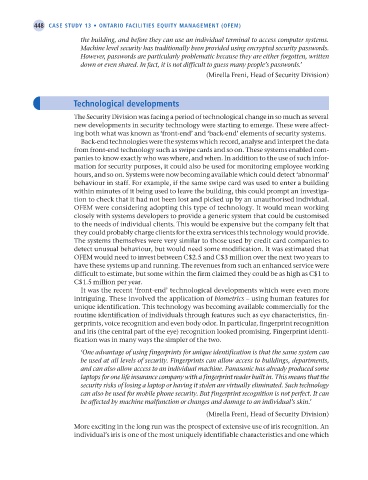Page 473 - Operations Strategy
P. 473
448 case study 13 • OntariO facilities equity management (Ofem)
the building, and before they can use an individual terminal to access computer systems.
Machine level security has traditionally been provided using encrypted security passwords.
However, passwords are particularly problematic because they are either forgotten, written
down or even shared. In fact, it is not difficult to guess many people’s passwords.’
( Mirella Freni, Head of Security Division)
technological developments
The Security Division was facing a period of technological change in so much as several
new developments in security technology were starting to emerge. These were affect-
ing both what was known as ‘front-end’ and ‘back-end’ elements of security systems.
Back-end technologies were the systems which record, analyse and interpret the data
from front-end technology such as swipe cards and so on. These systems enabled com-
panies to know exactly who was where, and when. In addition to the use of such infor-
mation for security purposes, it could also be used for monitoring employee working
hours, and so on. Systems were now becoming available which could detect ‘abnormal’
behaviour in staff. For example, if the same swipe card was used to enter a building
within minutes of it being used to leave the building, this could prompt an investiga-
tion to check that it had not been lost and picked up by an unauthorised individual.
OFEM were considering adopting this type of technology. It would mean working
closely with systems developers to provide a generic system that could be customised
to the needs of individual clients. This would be expensive but the company felt that
they could probably charge clients for the extra services this technology would provide.
The systems themselves were very similar to those used by credit card companies to
detect unusual behaviour, but would need some modification. It was estimated that
OFEM would need to invest between C$2.5 and C$3 million over the next two years to
have these systems up and running. The revenues from such an enhanced service were
difficult to estimate, but some within the firm claimed they could be as high as C$1 to
C$1.5 million per year.
It was the recent ‘front-end’ technological developments which were even more
intriguing. These involved the application of biometrics – using human features for
unique identification. This technology was becoming available commercially for the
routine identification of individuals through features such as eye characteristics, fin-
gerprints, voice recognition and even body odor. In particular, fingerprint recognition
and iris (the central part of the eye) recognition looked promising. Fingerprint identi-
fication was in many ways the simpler of the two.
‘One advantage of using fingerprints for unique identification is that the same system can
be used at all levels of security. Fingerprints can allow access to buildings, departments,
and can also allow access to an individual machine. Panasonic has already produced some
laptops for one life insurance company with a fingerprint reader built in. This means that the
security risks of losing a laptop or having it stolen are virtually eliminated. Such technology
can also be used for mobile phone security. But fingerprint recognition is not perfect. It can
be affected by machine malfunction or changes and damage to an individual’s skin.’
( Mirella Freni, Head of Security Division)
More exciting in the long run was the prospect of extensive use of iris recognition. An
individual’s iris is one of the most uniquely identifiable characteristics and one which
Z13 Operations Strategy 62492.indd 448 02/03/2017 13:58

